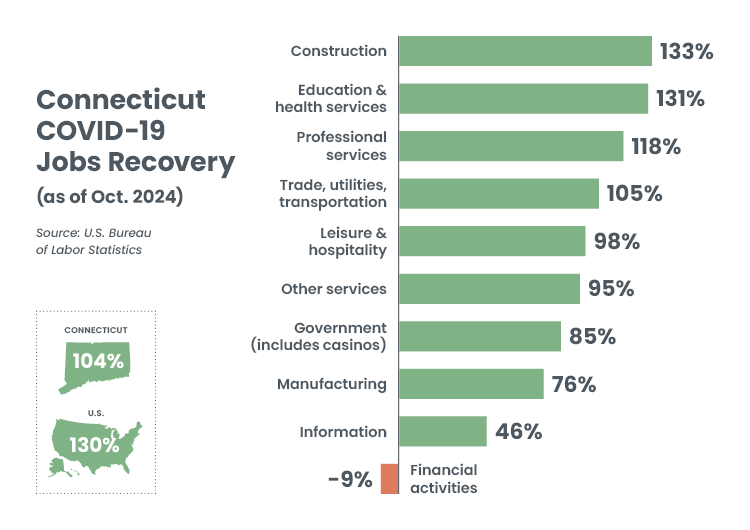Jobs Dilemma: As Openings Increase, Growth Stalls » CBIA

Connecticut employment declined for a fourth consecutive month in October, eroding the strong gains made through the first six months of the year.
Payrolls fell by 300 last month, with the state Department of Labor also revising September numbers to 1,300 losses from an initially reported 300-job decline in its latest monthly employment report.
Employers added 17,900 jobs through the first six months of the year (1%), while the following four months brought the loss of 4,700 positions.
Connecticut’s 12-month job growth is now just 0.5%, the slowest in the region and fifth worst in the country.
Vermont leads the New England states with 2.5% year-over-year employment growth, followed by Rhode Island (1.8%), New Hampshire (1.5%), Maine (1.1%), Massachusetts (0.9%), and Connecticut.
Nationally, employment increased 1.4% over the past 12 months.
Job Openings
While job growth has stalled in Connecticut, demand for workers is growing, with job openings up 2.6% in September to 80,000.
Since the pandemic hit in February 2020, job openings in the state have grown by 14%—the highest in the region and slightly below national growth.
However, the state’s labor force—the number of employed residents plus those actively looking for work—declined by 29,700 people (-1.5%) over the same period of time.
“It’s quite the dilemma,’ said CBIA president and CEO Chris DiPentima.

“While there is strong demand for Connecticut products and services, there’s simply not enough people to fill those jobs.”
Connecticut’s worrying labor force declines run contrary to regional and national trends—New Hampshire (-0.4%) is the only other New England with a smaller post-pandemic labor force.
At 2.7%, Rhode Island has seen the region’s strongest labor force growth, followed by Vermont (1.7%), Massachusetts (1.3%), Maine (1.3%), New Hampshire (-0.4%), and Connecticut.
Nationally, the labor force has grown 2.5% since February 2020.
Unemployment Rate
Connecticut’s unemployment rate fell again in October to an all-time low 3%, 12th lowest in the country.
“With a very low unemployment rate, low unemployment claims filing, and a steady labor force participation rate, this remains a tight job market for employers,” said DOL research director Patrick Flaherty.
“They are constrained by the smaller workforce post-pandemic. Job postings are still high even after moderating over the past few months.”
DiPentima said the data showed that Connecticut’s low unemployment rate was largely a reflection of the state’s labor force declines.
“The inability to fill those 80,000 job openings has real consequences for long-term economic growth.”
CBIA’s Chris DiPentima
“We currently have 1.4 job openings for every unemployed person and the inability to fill those openings has real consequences for long-term economic growth,” he said.
“Connecticut’s voluntary quits and separations rates are among the lowest in the country, labor participation is relatively high, and wage growth is strong.
“Employers have made talent recruitment and retention their top investment priority—now we need policymakers to focus on growing the population, expanding the workforce, and meeting the demands of our economy.
“We’re committed to working with the entire legislature to enact policies that will make Connecticut a more affordable place to live and work, and increase opportunities for meaningful, rewarding careers.”
Industry Sectors, Labor Markets
Three of Connecticut’s 10 major industry sectors posted employment gains in October, led by other services, which added 500 jobs (0.8%).
The leisure and hospitality sector also gained 500 jobs (0.3%) with trade, transportation, and utilities employment increasing by 400 (0.1%).
Employment in the manufacturing, construction, and information sectors was unchanged for the month.
The government sector, which includes local, state, and federal government and casino employment, lost 1,200 jobs (-0.5%) to lead all losing sectors.


Education and health services declined by 300 jobs (-0.1%), followed by financial activities (-100; -0.1%) and professional and business services (-100; -0.04%).
Education and health services, construction, professional services, and trade, utilities, and transportation are the only sectors to full recover all pandemic job losses.
Two of the state’s six major labor market areas posted gains in October, with Norwich-New London-Westerly gaining 500 jobs (0.4%) and Bridgeport-Stamford-Norwalk adding 200 (0.05%). Waterbury was unchanged for the month.
Hartford-West Hartford-East Hartford lost 500 jobs (-0.1%), with New Haven declining by 300 (-0.1%) and Danbury down 100 (-0.1%).
Related
A top recruiter says sports marketing roles are hot right…
Jobs are opening up in the sports industry as teams expand and money flows into the industry.Excel Search &
Public employees and the private job market: Where will fired…
Fired federal workers are looking at what their futures hold. One question that's come up: Can they find similar salaries and benefits in the private sector?
Mortgage and refinance rates today, March 8, 2025: Rates fall…
After two days of increases, mortgage rates are back down again today. According to Zillow, the average 30-year fixed rate has decreased by four basis points t
U.S. economy adds jobs as federal layoffs and rising unemployment…
Julia Coronado: I think it's too early to say that the U.S. is heading to a recession. Certainly, we have seen the U.S. just continue t










